Sometimes, the history of even the most cherished classic cars can be tinged with sadness. Such is the case with this 1954 Hudson Hornet. It is a low-mileage car that presents beautifully and underwent a meticulous restoration that returned it to showroom condition. Unfortunately, its passionate owner suffered from failing health as the restoration ended. They passed away without the opportunity to savor their creation, and the Hornet is listed for sale here on eBay to settle their estate. Located in Cincinnati, Ohio, bidding has raced to $9,600 in a No Reserve auction. I must say a big thank you to Barn Finder Larry D for spotting this fantastic Hudson for us.
The 1954 model year marked a significant change for the Hornet. The company elected to restyle the body to provide a squarer appearance while retaining their revolutionary “step down” design that gives the vehicle a low and sleek appearance. The restoration of this Hudson began twenty-five years ago, and its late owner commenced their labor of love from a sound base. The car had led a sheltered life, always garage-kept away from the elements. The panels wear fresh paint in the car’s original combination of Pasture Green and Coronation Cream. The paint shines impressively with a depth that makes you feel like you could walk into it. It coats laser-straight panels, and the seller indicates that the Hornet is rust-free. The chrome and stainless trim offers a striking contrast to the Green paint and shows no evidence of physical damage or corrosion. The glass is excellent, and the narrow whitewall tires add the perfect finishing touch to the exterior.
Some potential buyers saw the lack of a V8 option within the Hornet range as a source of weakness. However, the company’s 308ci flathead six-cylinder engine was no slug. The gentle giant produced 170hp and an earth-moving 278 ft/lbs of torque when equipped as this car is with the optional H-Power intake and carburetors. The original owner selected a three-speed automatic transmission, and this combination should launch the vehicle through the ¼ mile in 18.9 seconds before winding its way to 102mph. Those figures looked mighty impressive during the 1950s, helping explain why the brand experienced considerable success in the world of stock car racing. The seller indicates that this classic has 14,310 genuine miles on its odometer but fails to mention verifying evidence. If it exists, it makes the car an extraordinary find. Even if it has rolled over, the news remains positive. The Hudson runs and drives extremely well. Its engine sounds clean and strong, with the seller stating it is ready for a cross-country journey. It sounds like the winning bidder can fly in and drive this baby home.
The deceased owner tackled their build as a total package, which shows. With the exterior presenting impressively, I spent considerable time examining the Hudson’s interior shots seeking a fault or flaw. I finally found one when I discovered a pair of cracks in the wheel rim. Beyond that, there’s little of which to be critical. The green cloth seat upholstery is free from wear, and the back seat looks to have never been used. The remaining upholstered surfaces continue that theme, while the headliner and carpet are new. The dash is a highlight for me, with the chrome trim and painted surfaces contrasting beautifully. There are no aftermarket additions, with the AM radio retaining its rightful place in the dash.
The pages of automotive history books are littered with the names of manufacturers that have come and gone while barely causing a ripple. Their failure can be due to mismanagement, bad products, or bad timing. For Hudson, the inability to compete with the “big three” brought about its demise. Even a merger with Nash to form American Motors Corporation failed to keep the wolves from the door, with the Hudson brand retired in 1957. Today, Hudson has experienced a revival within the classic market, and this 1954 Hornet is a beautiful example. I will always admire a vehicle like this that has been restored to a high standard, but I also feel sadness that the restorer never managed to enjoy the fruits of their labor. However, with No Reserve in play, it is days away from finding a new home with someone who will undoubtedly appreciate this stunning classic. That seems a fitting way to conclude one chapter of this Hudson’s story. The new owner will have the chance to write its next one.
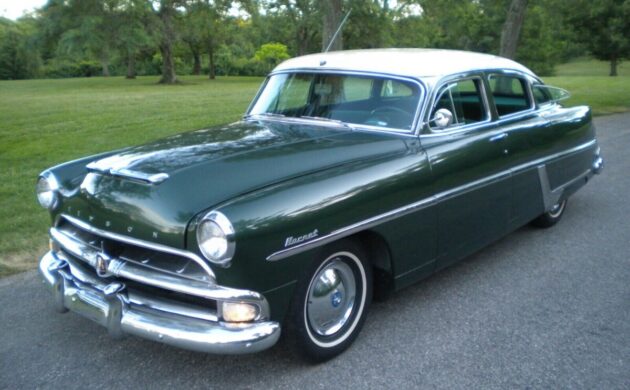
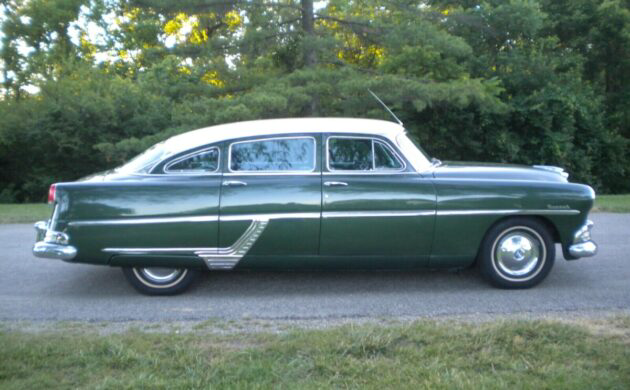
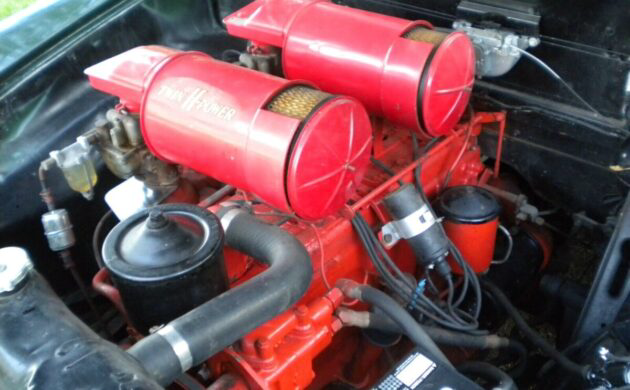
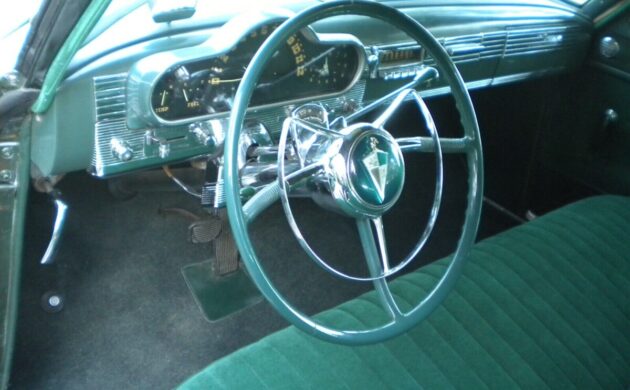
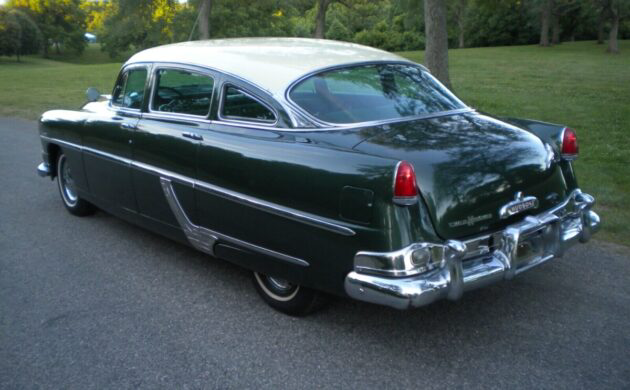


Beautiful and classy!
Fantastic dash.
Wow, that interior is incredible! Heck of a bargain right now.
Beautiful well-kept shape! Unfortunately, by `54 These were so hopelessly outdated in styling and dumpy looking they weren’t well-received by the public.
Styling of a 54 Chev or Ford just as outdated and dumpy, just compare. To correct the author, this Hudson has a dual range Hydramatic transmission, all of which are 4 speeds, not a 3 speed. Part of the struggle for the independents to get sales, was the Ford verses Chevy sales war, where those cars were shipped to dealers en mass, whether they ordered them or not, and those dealers were forced to sell new Chevs and Fords at near cost. Hard for Hudson to compete. Hudsons were a vastly better car, and cost more to build than big 3 cars, but customers looked at price first.
Back in the day, Hudson, Nash, Studebaker, Packard, Kaiser and Frazer were never received well. They weren’t built by GM, Ford, or Chrysler. The independent manufacturers could never really succeed, because the big three kept them small. Look at the history of Tucker. Preston Tucker fought them and lost…..He won the battle but the big three made sure he was bankrupted. Accordingly, when Nash and Hudson got together, they did so out of necessity, because the big three was doing everything they could to put them out of business, likewise with Studebaker and Packard. The big three had al the “in” people while the independents got what was left, some of whom were crooked, or were milking the business or even wasting money that they didn’t have to try to keep up with the big three.
What hurt Hudson the most is what was touted as a major advantage when their designs first hit the showrooms in 1948 with the ‘stepdown’ design. No body on frame construction here.The revolutionary ‘ monobilt ‘ unibody eliminated extra weight and lowered the car height considerably. Problem was, it was not an easy car to redesign. In fact you could only modify the sheet metal and chrome only so much. 1954 was the last year for the genuine Detroit built Hudsons and sadly only 35000 copies of all Hudsons for that year were made. A really nice example here.
This is a nice 54 Hudson Hornet, but my guess is that it has seen more than 14K miles. The brake pedal has considerable wear. In addition, all four door panels have certainly been redone. The solid vinyl panels above and below the center cloth regions should be ribbed. The 1/2″ trim strip separating those regions were a chrome tape on regular 54 Hornets but were chrome strips on 54 Hornet Specials. Both styles of these trim strips are hard to come by so the use of the solid green strips are understandable. I think the seats have been redone, too. In all the 54 Hornets that I have seen there is a strong contrast of the color of the material used between the pleated areas of the seats and the smooth regions. Possibly the carpets are original. The car has factory power steering in addition to the more desirable Hydramatic transmission (compared to the Borg Warner that some had) and also back up lights which are not too common. I see that now the car has sold for $12,850. The buyer is getting an excellent car.
Sold
US $12,850.00
They might have gotten more if they had been patient about allowing for more bidding. Haste makes waste.
Someone got a good deal on a really fine rare car. Hopefully it will be out and about for people to see.
“The 1954 model year marked a significant change for the Hornet. The company elected to restyle the body to provide a squarer appearance while retaining their revolutionary “step down” design that gives the vehicle a low and sleek appearance.” They didnt “elect” to restyle ; its not like they had a choice . The step downs were a good design, but Hudson’s limited funds prevented them from doing anything but restyling the old platform year after year , and it hurt the min sales